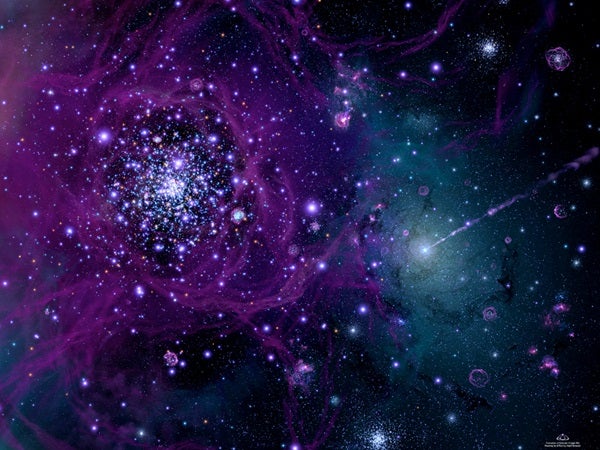Before WMAP and Planck, the best approach for determining the universe’s age relied on the much-debated Hubble constant, a figure that describes the rate at which the universe is expanding. To find the Hubble constant, astronomers observe distant galaxies and measure their distances (by using Cepheid variable stars or other objects of known intrinsic brightness) as well as how fast they recede from Earth. They then determine the Hubble constant by dividing the galaxy’s speed of recession by its distance. Once they decide on a value for the Hubble constant, they can estimate the maximum age of the universe by calculating the constant’s reciprocal.

Bringing the universe to your door. We’re excited to announce Astronomy magazine’s new Space and Beyond subscription box – a quarterly adventure, curated with an astronomy-themed collection in every box. Learn More >>.
But there was a problem. The values astronomers got for the Hubble constant depended on various assumptions about the universe’s density and composition and the method used to determine distances. So astronomers of different mindsets got different values for the constant.
They generally divided into two camps, one in the range of 50 kilometers per second per megaparsec and the other up at 80 km/sec/Mpc. (A megaparsec equals 3.26 million light-years, or about 20 billion billion miles.) Therefore, the two groups estimated a range for the age of the universe of about 10 to 16 billion years. (Higher values of the Hubble constant produce younger age values for the universe.) Research by various groups, including Wendy Freedman and her colleagues in the Key Project — astronomers who were using the Hubble Space Telescope to measure the distances to many galaxies — narrowed in on a value toward the faster, and thus younger, end of the scale. But uncertainties still remained.
The other series of approaches for determining the universe’s age attempted to directly measure the ages of the oldest objects in the universe. Astronomers can estimate the age of the cosmos by measuring the decay of radioactive elements. This technique yields ages of 4.4 billion years for the oldest rocks on Earth (zircons found in Jack Hills, Australia) and 4.6 billion years for the oldest meteorites, effectively dating the solar system but not the universe.
Alternatively, astronomers measured the ages of white-dwarf stars, the shrunken remnants of stars that are as heavy as the Sun but only as large as Earth. By finding the faintest, and thus oldest, white dwarfs, astronomers estimated how long they have been cooling.
Comprehensive attempts at cataloging white dwarfs and measuring their ages yielded about 10 billion years for the age of the Milky Way’s disk. The galaxy’s disk formed about 2 billion years after the Big Bang, yielding an age of the universe of about 12 billion years.
Measuring the ages of ancient star clusters offers yet another avenue for exploring the age of the universe. By looking at the most luminous stars in a globular cluster, astronomers can determine an upper limit for the cluster’s age. They look at the brightest stars on the so-called main sequence — the primary track on a plot of stellar brightnesses versus temperatures.
Such studies of numerous globulars, based on distance measurements provided by the European Space Agency’s Hipparcos and Gaia missions, suggested an age for many of the oldest stars of around 13 billion years. And astronomers think the age of globulars gives a pretty good indication for the age of the universe. That’s because globulars contain hardly any elements heavier than hydrogen and helium, and so had to be among the first objects to form.
Any discrepancies narrowed significantly with the release of WMAP data, before essentially disappearing when researchers announced Planck’s latest findings in 2015. By carefully examining the microwave background radiation, astronomers have pinned down the universe’s age to 13.8 billion years, accurate to better than 1 percent. The results pretty much ended the debate, but what a debate it was.











